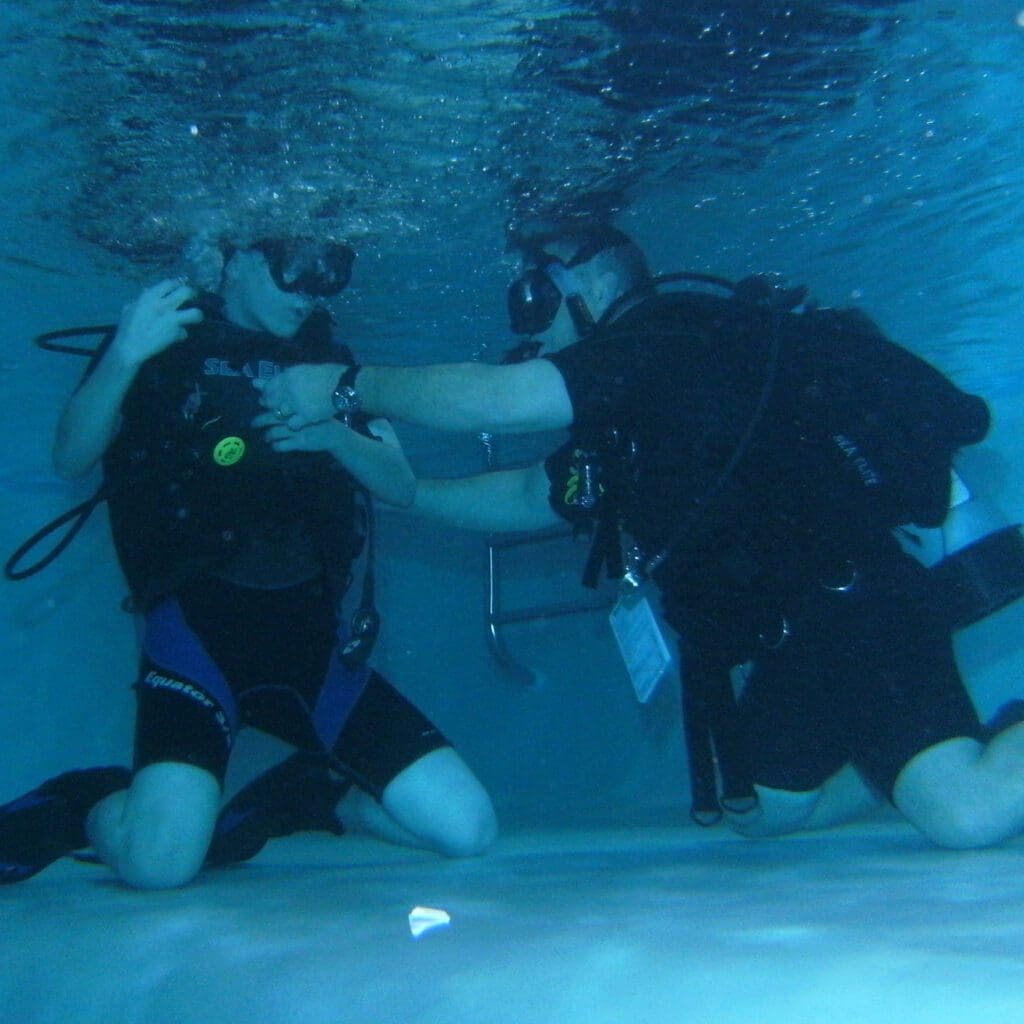Let’s face it, we do things that “normal” people balk at. We go deep, we explore underwater cave systems, we penetrate wrecks, we swim with sharks and other animals that movies are made about, and we have a blast the whole time we’re doing it. But you should never try diving until you’ve become certified by a licensed and insured instructor with experience doing that activity.
There is nothing haphazard about learning to scuba dive, and it’s a lot safer than walking across Federal Highway to grab a cup of coffee. The World Recreational Scuba Training Council (WRSTC) establishes the standards for scuba diving training that are followed by all scuba certification organizations. These minimum training standards ensure the most consistent and safest training practices for all recreational scuba divers.
The agencies that base their training curriculum on WRSTC standards include powerhouses like PADI (Professional Association of Diving Instructors); SSI (Scuba Schools International); NAUI (National Association of Underwater Instructors); and SDI (Scuba Diving International) among others. And though each training organization may brand the different levels slightly differently, they all have the same requirements for training.
Compare the four major training agencies, what they call the certification levels, and what the requirements are to see how the WRSTC gives us a continuity of training across all agencies.
PADI Levels
- Open Water Diver: The entry-level certification that allows you to dive up to 18 meters (60 feet) with a buddy.
- Advanced Open Water Diver: This certification requires five adventure dives and allows you to dive up to 30 meters (100 feet).
- Rescue Diver: Focuses on developing rescue skills and managing diving emergencies.
- Master Scuba Diver: The highest non-professional level, requiring five PADI Specialty Diver courses and 50 logged dives.
SSI Levels
- Open Water Diver: The entry-level certification that allows you to dive up to 18 meters (60 feet) with a buddy.
- Specialty Diver: Complete 2 Specialty Programs and 12 logged dives.
- Advanced Open Water Diver: Complete 4 Specialty Programs and 24 logged dives.
- Master Diver: Complete 4 Specialty Programs, Diver Stress & Rescue, and 50 logged dives.
NAUI Levels
- Scuba Diver: The entry-level certification that allows you to dive up to 18 meters (60 feet) with a buddy.
- Advanced Scuba Diver: This certification requires additional training and dives, allowing you to dive deeper and explore more challenging environments.
- Rescue Diver: Focuses on developing rescue skills and managing diving emergencies.
- Master Scuba Diver: A higher level of certification that includes advanced training in various diving skills and specialties.
SDI Levels
- Open Water Scuba Diver: The entry-level certification that allows you to dive up to 18 meters (60 feet) with a buddy.
- Advanced Adventure Diver: This certification requires additional training and dives, allowing you to explore more challenging environments.
- Rescue Diver: Focuses on developing rescue skills and managing diving emergencies.
- Master Scuba Diver: A higher level of certification that includes advanced training in various diving skills and specialties.
The regularity of training requirements allows recreational scuba divers to mix and match their certifications. As an example, your author has lots of PADI certifications but is certified to dive NITROX by NAUI. It was just the choice that was available at the time, and the education, training and experience crossover easily.
So, while many dive outfits may limit participation in a dive to a certain skill level, they don’t need to worry about what you call your certification card. In other words, many dives require advanced skills, and you cannot participate if you don’t hold an advanced certification. The Advanced Open Water certifications from PADI and SSI are equivalent to NAUI’s Advanced Scuba Diver and SDI’s Advanced Adventure Diver, but they all certify that you have trained and are ready to dive to the recreational maximum depth of 130 feet or 40 meters.
Are you ready to be certified?
The world is full of people who watch TV and dream about learning how to scuba dive. But once you decide to do it, just exactly how do you find an instructor? The members of Out Scuba are a cross section of training agencies, but we all agree on one thing: make sure you trust the outfit/instructors that are training you.
We’re very proud of our Out Scuba instructor members, who can be found on our Instructors page on the website. They each offer a variety of certifications and specialties and can train you in private or group settings.
Scuba diving involves some inherent risk, but there should never be a sense of bravado or unnecessary risk taking during your training. Your instructor should be willing to explain each skill to you as many times as you need, and you should master each skill before moving on to the next. This is called skills mastery training and is followed by all certification agencies.
The most important skill I learned in my scuba training was to not panic if a situation came up that seemed scary. All of your training is based on teaching you how to dive safely, secure in the knowledge that you can handle situations wherever they may pop up. Luckily, very few of us have to use these emergency procedures in real life, and are more apt to be practicing buoyancy skills rather than Controlled Emergency Swimming Assents (CESA).
If you have questions about getting certified, please contact us! We’ll be happy to talk to you about your situation, answer any questions and share with you our experiences. But if you’re ready to explore the underwater world, get off your sofa and come join us. You’ll wonder why you waited so long.

